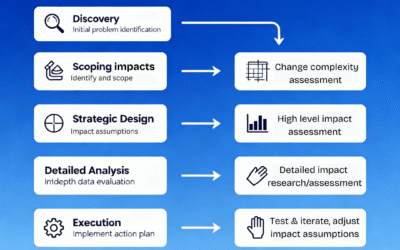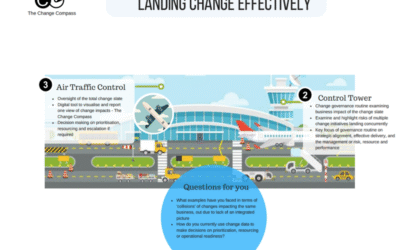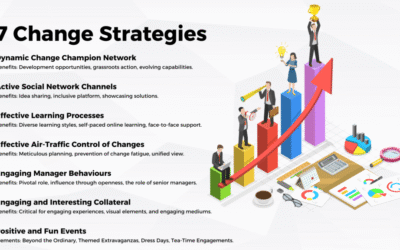Right now I am writing this article from a Four Seasons resort in Hawaii after having 3 flights cancelled in a row. It has been quite a stressful experience as you can imagine and it’s the fourth day of delay. I’m not able to get back home! However, this started to get me thinking about the change experience for the employee or the customer. As change drivers or leaders we tend to focus on how to design the change at a program level and it’s rare for us to really get down to the lowest level of people experience and how this is perceived at a humanistic level throughout the change process.
In the past I’ve used the airport analogy to describe the change journey and how we work to design each of the elements of the whole ecosystem, including pre-departure, transit, in-flight experience, runway preparation and post-landing experience. To read more about each of these elements refer to this article on Landing multiple changes in a complex environment.
Now let’s take a look at my recent bad flight experience and you will see that this easily translates to a typical change experience for those impacted. My first flight was cancelled, and after several hours all passengers were feeling frustrated, wondering what was really going on, and when or if the flight will take off. The announcement did not provide any substantive information and so as a result each passenger had to queue up to ask for further information. This is similar to a restructuring announcement or other major changes whereby there is a generic corporate email sent to all impacted, however the information is so generic that employees will need to resort to their managers (or rumours) to get further information that will meet their individual needs.
For the managers, they often don’t receive the right information or it is insufficiently tailored so that they are not able to translate the organisational level impact to how their specific department or team will be impacted. This could be due to lack of information or skill set in translating the impact for their teams. To this end, we need to ensure we engage with those managers to ensure that their questions are answered and that they’re able to field employe questions, versus having no information.
Part of a good change experience is in anticipating any reactions, feelings and designing an effective process that tackles these head on. To do this, use a human-centred design approach of observation, interviewing, analysing precious incidents and basically adopt a human-centred mindset to pick out key experience insights that need to be addressed. To read more about the human-centred design process please click here.
So what can we learn from the bad pre-departure experience when applied to change?
1. Provide managers and leaders with sufficient information so that they are able to engage with and consult with their impacted employees to ensure that their needs are met, including gathering new ideas from them.
2. Conduct a detailed analysis from an end-user perspective to pre-determine potential humanistic needs and reactions and address these head-on. For example, What types of information are needed to reach the ultimate goal? What are potential employee questions? How do we provide them with effective engagement prior to them asking for it?
3. Proactive engagement to manage potentially negative feelings. Being on the receiving end of a flight cancellation or a successful change initiative is often frustrating and stressful. How do we anticipate these experiences to redesign it into a more positive one? For example, are there certain employee groups we can garner to be change champions to provide additional people support and foster resilience? What artefacts can we provide to shape these experiences? Visually-catching cheat sheets, posters, branded sweets, morning-tea, and effective social media communication, etc.
4. Involve all layers of management so that they are well-equipped to support the change management process and are clear with their role in the process. Are we simply asking them to be on-hand to answer questions? Or do we expect certain layers of management to be change coaches to guide first-line managers on how to lead change and foster a culture of continuous improvement through hard work? What are we asking our Human Resources colleagues to be doing? Or our Risk partners or Finance partners? Be explicit about what specific behaviours and outcomes we are asking for.
5. Empathy. When people are frustrated, feeling vulnerable or stressed, the most important thing to do to address their feelings is to acknowledge and address these feelings by showing empathy. After all we are dealing with people’s emotions. Emotions are not logical and therefore data and facts usually do not create empathy. Empathy is between two individuals. One person showing another person that their feelings are valid, acknowledged and supported. Empathy is best demonstrated through verbal or nonverbal behaviours rather than through emails and online information. This is about a leader or another colleague showing genuine acknowledgement that a fellow colleague feels a certain way, without providing any judgment or even advice. During one of the days when the flight was cancelled, a staff walked around and chatted to everyone in the queue to just listen to them and acknowledge their frustrations – this did more good than anything else the airline did.
6. Create an element of surprise in designing the change process. Most corporate change processes are similar in that they follow a set way of engaging with employees according to the corporate norm of what has worked in the past. However, there are some organizations that keep following norms and do not create a good change experience and keep repeating the same mistakes over a long time. I’m sure we have all experienced this J. For example, it could be a new way for a senior leader walking the floor to connect with impacted employees and stakeholders during the change process, or corporate artefacts that were not anticipated and could be perceived in a positive light.
7. Appealing to the senses. A lot of people remember sensory information more than data or facts. How do we leverage this to create the overall experience? Retail stores often dispense aromatherapy scents to create and environment or calm or excitement depending on the desired experience. Visual information is also important to create the right imagery so that employees can visualise the light at the end of the tunnel and be inspired to go through the tunnel. One can design visual images that help employee remember themes, or analogies that are easily understood and visualised (and therefore easily memorised).
My experience with The Four Seasons hotel from when I entered the hotel through to using its various amenities is that there is significant care and detailed anticipation of user needs. From personal interactions with staff that show care and rapport, through to facilities that are carefully designed to incorporate guest needs. For me the surprise element was the room iPad greeting me with my name and giving me a run down of the weather, things to do and other location and hotel references. The challenge for us as change leaders is to learn from this and think through how we design great change experience that are out of the ordinary and far from the typical ho-hum corporate approaches in initiative roll out.
Share this post with your contacts.






